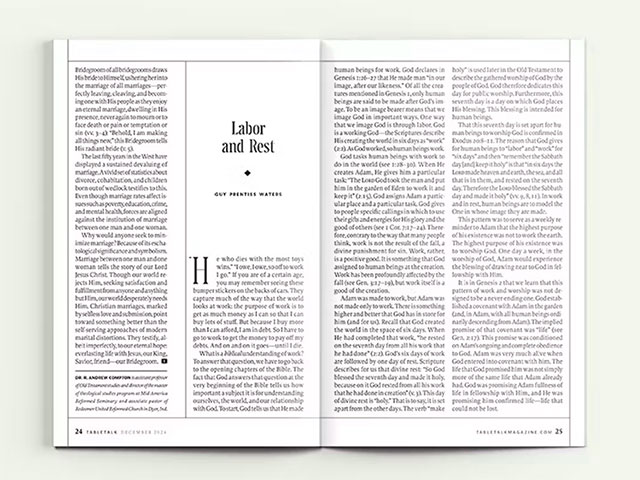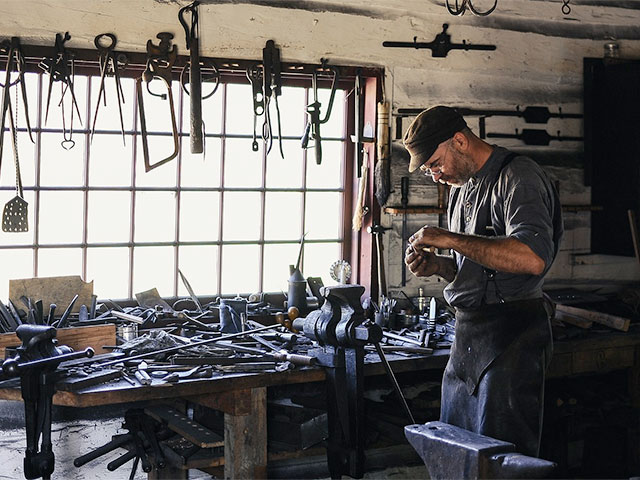Labor and Rest
From TABLETALK
“He who dies with the most toys wins.” “I owe, I owe, so off to work I go.” If you are of a certain age, you may remember seeing these bumper stickers on the backs of cars. They capture much of the way that the world looks at work: the purpose of work is to get as much money as I can so that I can buy lots of stuff. But because I buy more than I can afford, I am in debt. So I have to go to work to get the money to pay off my debts. And on and on it goes—until I die.
What is a biblical understanding of work? To answer that question, we have to go back to the opening chapters of the Bible. The fact that God answers that question at the very beginning of the Bible tells us how important a subject it is for understanding ourselves, the world, and our relationship with God. To start, God tells us that He made human beings for work. God declares in Genesis 1:26–27 that He made man “in our image, after our likeness.” Of all the creatures mentioned in Genesis 1, only human beings are said to be made after God’s image. To be an image bearer means that we image God in important ways. One way that we image God is through labor. God is a working God—the Scriptures describe His creating the world in six days as “work” (2:2). As God worked, so human beings work.
God tasks human beings with work to do in the world (see 1:28–30). When He creates Adam, He gives him a particular task: “The Lord God took the man and put him in the garden of Eden to work it and keep it” (2:15). God assigns Adam a particular place and a particular task. God gives to people specific callings in which to use their gifts and energies for His glory and the good of others (see 1 Cor. 7:17–24). Therefore, contrary to the way that many people think, work is not the result of the fall, a divine punishment for sin. Work, rather, is a positive good. It is something that God assigned to human beings at the creation. Work has been profoundly affected by the fall (see Gen. 3:17–19), but work itself is a good of the creation.
Adam was made to work, but Adam was not made only to work. There is something higher and better that God has in store for him (and for us). Recall that God created the world in the space of six days. When He had completed that work, “he rested on the seventh day from all his work that he had done” (2:2). God’s six days of work are followed by one day of rest. Scripture describes for us that divine rest: “So God blessed the seventh day and made it holy, because on it God rested from all his work that he had done in creation” (v. 3). This day of divine rest is “holy.” That is to say, it is set apart from the other days. The verb “make holy” is used later in the Old Testament to describe the gathered worship of God by the people of God. God therefore dedicates this day for public worship. Furthermore, this seventh day is a day on which God places His blessing. This blessing is intended for human beings.
In work and in rest, human beings are to model the One in whose image they are made.
That this seventh day is set apart for human beings to worship God is confirmed in Exodus 20:8–11. The reason that God gives for human beings to “labor” and “work” for “six days” and then “remember the Sabbath day [and] keep it holy” is that “in six days the Lord made heaven and earth, the sea, and all that is in them, and rested on the seventh day. Therefore the Lord blessed the Sabbath day and made it holy” (vv. 9, 8, 11). In work and in rest, human beings are to model the One in whose image they are made.
This pattern was to serve as a weekly reminder to Adam that the highest purpose of his existence was not to work the earth. The highest purpose of his existence was to worship God. One day a week, in the worship of God, Adam would experience the blessing of drawing near to God in fellowship with Him.
It is in Genesis 2 that we learn that this pattern of work and worship was not designed to be a never-ending one. God established a covenant with Adam in the garden (and, in Adam, with all human beings ordinarily descending from Adam). The implied promise of that covenant was “life” (see Gen. 2:17). This promise was conditioned on Adam’s ongoing and complete obedience to God. Adam was very much alive when God entered into covenant with him. The life that God promised him was not simply more of the same life that Adam already had. God was promising Adam fullness of life in fellowship with Him, and He was promising him confirmed life—life that could not be lost.
But because of sin, Adam not only lost the opportunity to gain that offer of life, but he also lost what he already had. And as God had promised, Adam’s sin brought death to himself and to us (Gen. 2:17). After he sinned, Adam fled from God and tried to hide from Him—he wanted nothing to do with fellowship or worship (3:7–8). Work fell under the curse of God, and the worship that God had appointed for Adam seemed an impossibility. Eternal death, not eternal life, was what awaited human beings.

Thankfully, curse and death were not God’s last word. In Genesis 3:15, He makes the first announcement of His intention to save sinners through the work of His Son, the offspring of the woman. The whole Old Testament is preparation for Christ to come, and the whole New Testament explains the person and the work of the Savior who has come. Adam was a “type” of Christ, who is the “last Adam,” the “second man” (Rom. 5:14; 1 Cor. 15:45, 47). Christ has accomplished two things. First, He has undone what we have done in Adam. In going to the cross, Christ has made satisfaction for the sins of sinners, propitiated the wrath of God, and redeemed a people to God. Second, He has done what we have failed to do in Adam. Christ was the servant of God, entirely obedient to Him, all the way to His death on the cross (Phil. 2:7–8). By His obedience, death, and resurrection, He has secured eternal life for His people. He freely gives that eternal life to His people through the gospel by the ministry of the Holy Spirit.
Therefore, every believer in Christ is in the most secure place imaginable. Christ has taken us to the place where Adam should have gone but did not go. He has “abolished death and brought life and immortality to light through the gospel” (2 Tim. 1:10). Although we die, we die in the hope of the resurrection. The “second death” will not hurt us (Rev. 2:11; 20:6; see also 20:14; 21:8). Those who “die in the Lord” will “rest from their labors” (14:13). But this rest is not the rest of inactivity. We will be most active—in the worship of God and in the fellowship of the saints (see 7:9–17). What’s more, death, mourning, crying, and pain will be no more in the new heavens and new earth (21:4).
Between the resurrection of Christ and the return of Christ, God’s people continue to work and to worship. Hebrews tells us that “there remains a Sabbath rest for the people of God” (Heb. 4:9). One day a week, we gather with our brothers and sisters in the public worship of our great God. That day, however, now falls on the first day of the week and no longer the last day of the week (see Acts 20:7; 1 Cor. 16:2), the day that John calls “the Lord’s day” (Rev. 1:10). The first day of the week is the day, of course, when Christ was raised from the dead. As the last day of the week commemorated God’s creation, so the first day of the week now commemorates God’s new creation in Christ.
In public worship, then, we are doing something wonderful with our brothers and sisters. We are gathering to hear God’s Word read and preached. We are remembering what God has done for us in Christ and what is in store for us in Christ. On Monday morning, we return to our callings, working to the glory of God. But Sunday has given us a reminder and a foretaste of something far greater that lies ahead of us: the fullness of the fellowship, life, and rest that God has provided for us in Jesus Christ. We worship, we work, and we wait, knowing that the best is yet to come.
Dr. Guy Prentiss Waters is James M. Baird Jr. Professor of New Testament at Reformed Theological Seminary in Jackson, Miss., and a teaching elder in the Presbyterian Church in America. He is author of several books, including How Jesus Runs the Church and Facing the Last Enemy.


Recent Comments